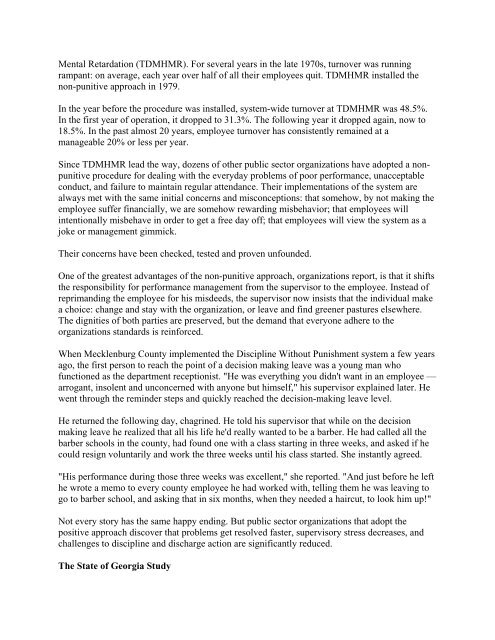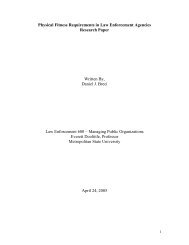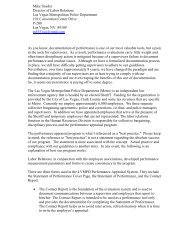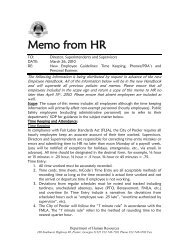Public Sector Organizations: Today's Innovative Leaders In ... - IPMA
Public Sector Organizations: Today's Innovative Leaders In ... - IPMA
Public Sector Organizations: Today's Innovative Leaders In ... - IPMA
- No tags were found...
You also want an ePaper? Increase the reach of your titles
YUMPU automatically turns print PDFs into web optimized ePapers that Google loves.
Mental Retardation (TDMHMR). For several years in the late 1970s, turnover was runningrampant: on average, each year over half of all their employees quit. TDMHMR installed thenon-punitive approach in 1979.<strong>In</strong> the year before the procedure was installed, system-wide turnover at TDMHMR was 48.5%.<strong>In</strong> the first year of operation, it dropped to 31.3%. The following year it dropped again, now to18.5%. <strong>In</strong> the past almost 20 years, employee turnover has consistently remained at amanageable 20% or less per year.Since TDMHMR lead the way, dozens of other public sector organizations have adopted a nonpunitiveprocedure for dealing with the everyday problems of poor performance, unacceptableconduct, and failure to maintain regular attendance. Their implementations of the system arealways met with the same initial concerns and misconceptions: that somehow, by not making theemployee suffer financially, we are somehow rewarding misbehavior; that employees willintentionally misbehave in order to get a free day off; that employees will view the system as ajoke or management gimmick.Their concerns have been checked, tested and proven unfounded.One of the greatest advantages of the non-punitive approach, organizations report, is that it shiftsthe responsibility for performance management from the supervisor to the employee. <strong>In</strong>stead ofreprimanding the employee for his misdeeds, the supervisor now insists that the individual makea choice: change and stay with the organization, or leave and find greener pastures elsewhere.The dignities of both parties are preserved, but the demand that everyone adhere to theorganizations standards is reinforced.When Mecklenburg County implemented the Discipline Without Punishment system a few yearsago, the first person to reach the point of a decision making leave was a young man whofunctioned as the department receptionist. "He was everything you didn't want in an employee —arrogant, insolent and unconcerned with anyone but himself," his supervisor explained later. Hewent through the reminder steps and quickly reached the decision-making leave level.He returned the following day, chagrined. He told his supervisor that while on the decisionmaking leave he realized that all his life he'd really wanted to be a barber. He had called all thebarber schools in the county, had found one with a class starting in three weeks, and asked if hecould resign voluntarily and work the three weeks until his class started. She instantly agreed."His performance during those three weeks was excellent," she reported. "And just before he lefthe wrote a memo to every county employee he had worked with, telling them he was leaving togo to barber school, and asking that in six months, when they needed a haircut, to look him up!"Not every story has the same happy ending. But public sector organizations that adopt thepositive approach discover that problems get resolved faster, supervisory stress decreases, andchallenges to discipline and discharge action are significantly reduced.The State of Georgia Study
















